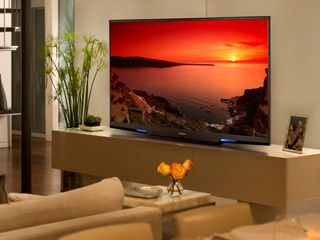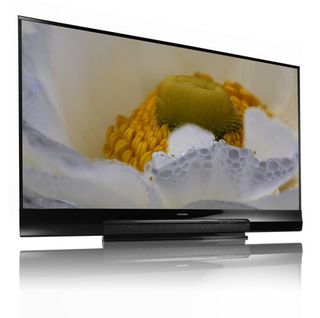What is a home cinema laser display?
Home cinema nuts could be about to get a blast from the past

Big, bulky and brilliant, rear-projection TVs were among the first show-off TVs, but died-out in the UK a few years ago when the TV world went flat. Now it's back - and set to deliver the best 3D pictures yet from a far thinner design.
Using new laser tech, Mitsubishi is about to put its home cinema laser display (a variant of which is available in the US) in front of the watching world at IFA 2011 in Berlin. The Japanese company hopes to gauge interest in its technology, and has tentative plans to launch a laser display in Europe in 2012.
What is a home cinema laser display?
"It's based on rear projection laser technology that uses laser light to generate the picture," says Hans-Joerg Hinkel at Mitsubishi Electric Corporate Communications. "For that reason it doesn't have a colour wheel, with beams of laser light directed by a mirror to the screen."
Because it uses laser light, there's no need to replace a bulb every few years at great expense - one of the major complaints about rear-pro TVs - though the unit that produces the laser light does need to be replaced every 40,000 hours.
Our calculations say that's eight hours per day for 10 years, which ought to see you through the lifetime of any TV. If not, you've got more to worry about than lasers.
Home cinema laser display vs LED and plasma
There is a good reason why the likes of Sony chose LCD and plasma over rear-pro tech, and it had nothing to do with picture quality.
Although the exact dimensions of a home cinema laser display aren't yet available, Mitsubishi already sells the 75-inch L75-A94 LaserVue TV in the US and Japan, under the LaserVue moniker.
Get daily insight, inspiration and deals in your inbox
Get the hottest deals available in your inbox plus news, reviews, opinion, analysis and more from the TechRadar team.
"The footprint is not much bigger than a current plasma display," says Hinkel, "and there is a good chance that any European-bound laser display will be a next-generation model, so will be slightly thinner."
The space a laser display takes is significantly less than an old-fashioned rear projection TV, but it's more than we're used to. The L75-A94 has a depth of 12.7-inches, or 32cm, which doesn't compare well to the latest high-end LED-backlit LCD or plasma TVs.

HOW BIG? Mitsubishi already sells this 92-inch rear-pro DLP TV in the US
How much will a home cinema laser display cost?
Price-wise, the laser displays should compete, albeit only at the high-end; the L75-A94 sells for around US$6,000 States-side. That's about £3,675 in real money, which compares well to Samsung's 60-inch UE60D8000 LED-backlit LCD TV (£4,500) and Panasonic's 65-inch TX-P65VT30 plasma (£4,000).
You're also getting at least an extra ten inches for the money - and the screens that hit Europe could be as big as 80-inches.
Why buy a home cinema laser display?
Put simply, the picture quality surpasses anything you've seen. Mitsubishi is hoping the technology's superior picture quality will win the day and convince movie fans to make allowances for its extra girth, especially those with a dedicated cinema room and who demand the best.
There's no colour wheel - as with DLP rear projection TVs that Mitsubishi also sell in the US - so there's no colour distortion. "The colours are generated by pure laser light so we get a 100% wider colour spectrum than on a plasma or LCD," says Hinkel. "It's very easy to see on reds - they're just so much more natural."
Can laser displays cope with 3D?
Oh yes - and we've already seen the US versions come up trumps with 3D at January's CES. "The big advantage for 3D is that laser displays are very bright," says Hinkel. "The main problems with 3D are that it is often very dark, and it needs a bigger screen to be life-like."
A 75-inch size assures the latter, while energy efficiency is also an ace-card. "Laser displays use 85W in operation and 0.5W in standby. That's a lot less than plasma or LED, and if you do watch 40,000 hours of TV it will make a huge difference!"
Why is it called a display, not a TV?
There won't be a tuner in it, so technically it can't be called a TV. "Most people using a rear-pro display will use their own source," says Hinkel. "There is no real need for a tuner, and in Europe there are five or six tuners, so it becomes a huge task - especially for a fairly low number of pieces."
Will the LaserVue soon be available in the UK?
Hopefully, though IFA will play a crucial role. "We want to see how people react at IFA, to see if it's accepted and seen as better than other displays," says Hinkel.
"The laser displays are manufactured in US, and it's a fairly niche market, to be honest. We've had a lot of requests from Europe, but it's not an easy decision to make to actually start selling it - we'll need good customer service, and go through the certification processes. We don't want to just throw something at the market, especially at this kind of price."
If it is brought to these shores, expect a name-change, says Hinkel: "They wont be called LaserVue in Europe - that name is associated with TVs, and this isn't a TV - it's a display."
TechRadar will report back from IFA with an eyewitness report.
Jamie is a freelance tech, travel and space journalist based in the UK. He’s been writing regularly for Techradar since it was launched in 2008 and also writes regularly for Forbes, The Telegraph, the South China Morning Post, Sky & Telescope and the Sky At Night magazine as well as other Future titles T3, Digital Camera World, All About Space and Space.com. He also edits two of his own websites, TravGear.com and WhenIsTheNextEclipse.com that reflect his obsession with travel gear and solar eclipse travel. He is the author of A Stargazing Program For Beginners (Springer, 2015),
Most Popular



